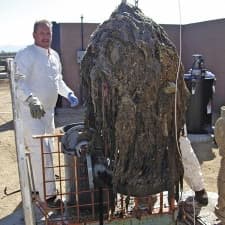AMWUA Blog
BY: Kathleen FerrisWhat You Flush Can Cost Cities Time And Money

Baby and facial wipes are one of the new problems for cities' wastewater systems. Just because a product is labeled flushable or disposable doesn't make it immediately biodegradable. Flushing wipes down a toilet is like flushing small cotton towels. The massive amounts of wipes being flushed every day get hung up on motors and create clogs. Any item meant to absorb liquids, such as diapers, paper towels, cotton balls and cat litter, also can hamper the operation of a city's wastewater system, as well as your own plumbing.
Valley cities rely on their customers' wastewater. Technology allows the wastewater flowing out of homes and businesses to be screened, treated and reused, mostly to irrigate landscaping and fill underground aquifers for use in times of water shortages. Palo Verde Nuclear Generating Station in the southwest Valley is cooled with treated wastewater supplied by five AMWUA cities. This saves drinking water for your home. It’s important for cities to keep reclaiming wastewater at the lowest cost possible. That’s why cities are concerned about what residents and businesses flush down their toilets and drains.
Cities depend on gravity to carry the wastewater that comes out of your home through a series of pipes and into the city’s treatment plant. Where gravity fails, motorized pumps give the system a boost.
For example, the city of Peoria maintains 700 miles of pipe that carry away wastewater. Engineers angle the pipes down and gravity keeps the wastewater flowing under neighborhoods and to the treatment plant. When the pipe gets too deep, the city builds a lift station where pumps lift the wastewater up to the next set of pipes and once again sends it sliding down toward the treatment plant.
Peoria public works employees clean miles of pipe every day with jet hoses and industrial vacuums to ensure the wastewater has a clear path to the treatment plant. It takes five years to make an entire 700-mile cleaning circuit.
When people flush the wrong types of items, it costs the city time and money. The wrong items can cause a sewage overflow through manholes and onto the streets.
Clots often make it though the well-cleaned pipes, but they can jam the pumps inside the lift stations and at the wastewater treatment center. These clots can burn out $100,000 motors and plug industrial screens. Public workers must then re-route or temporarily stop the flow while they clean up and repair the damage.
Here’s the simplest guide: Don’t use your toilet as a trash can. Your plumbing and your city’s aren’t built to handle it. There is more information about Peoria’s water and sewer system at the city’s website.
For 45 years, Arizona Municipal Water Users Association has worked to protect our member cities’ ability to provide assured, safe and sustainable water supplies to their communities. For more water information visit www.amwua.org.
